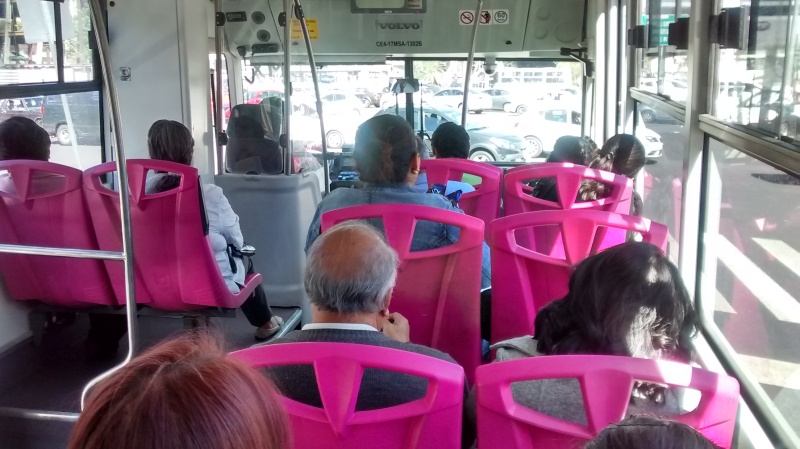Mexico City has a traffic congestion problem which results in a wide array of environmental, social and economic concerns, including air and noise pollution, high levels of stress, time lost transporting people and goods to their destinations and a generally negative effect on quality of life in the city.
While this congestion problem can be directly attributed to the sheer number of people living and moving around the city, I believe it also has some indirect origins: Perceptions of insecurity in public transportation, especially at night.

Front part of the Metrobús in Mexico City: Reserved for women, children and people with disabilities.
While the proportion of trips made daily by personal vehicle was just 29% in 2007 (compared to 68.6% of trips taken by a combination of privately-operated and publicly-operated public transportation)*, and the use of the personal automobile stems from the massive scale of the city (i.e. long distances between home and work) and a cultural preference for driving, I believe that this preference for personal transportation is also rooted in an underlying sense of insecurity in some parts of the city, a feeling that is then used to rationalize moving around by means of private transportation, be it personal automobile, taxi or UBER.
For example, one Friday night I made plans to go out with some friends in the Santa María la Ribera colonia of Mexico City. When I told my partner where I was going, he told me that I should not take public transportation to come home alone. Later that night, as we left the venue, two male friends asked me how I was getting home. When I responded that I would get a lift home with the same female friend that had driven me, they responded “Ok, good!” and proceeded to walk the both of us to the parking lot where we had left the car upon arriving. When I asked my female friend if she felt more comfortable going out at night if she was driving her car, she told me yes.
This sense of insecurity in the city, and particularly at night and for women, may have an important impact on mobility patterns – and it is not at all uncommon. For example, when I went to a dance class just ten minutes from my apartment and left to walk home around midnight, the goodbyes with the people I was with included “Ve con cuidado!” (Go with caution!). It has become as such ingrained in my mind that I am not safe when alone at night. Yes, perhaps these are just common sayings, like the vacuous “Hey, how are you?” that we use so often in North America, without pausing to hear the answer. However, it comes from somewhere, a general sense that the city is not a safe place.
I have been told since arriving in Mexico City:
– Don’t walk alone at night
– Don’t take the public transit at night. As soon as it is empty, do not take the metro or the metrobús
– Never take a taxi off the street. Call a cab or use UBER.
While this sense of insecurity is more prominent at night, therefore outside of peak hours and not necessity exacerbating the congestion problem directly, it creates a demand for personal transportation – a habit of driving or calling an UBER. Once an individual has purchased a car, the initial cost is sunk and this is an important incentive to keep driving, as the only additional cost is gas (where there are no parking fees or tolls). If one’s tank is already full, the perceived cost of the trip is null.
Of course, several cities have implemented policies to make users perceive the cost of driving, such as congestion pricing in London, Singapore and Stockholm, or adjusting parking fees, including in Mexico City’s central neighbourhoods and more famously in San Francisco. However, once this sense of insecurity exists, it incites a reaction. For some, namely those with the financial means, it results in driving a personal vehicle. Perhaps it is initially used when traveling at night, or for long trips, but once a habit is developed and the initial, sunk cost of car ownership is incurred, without policies that discourage driving such as parking fees and tolls, the result is an increasing number of trips made by car.
This general sense of insecurity also helps UBER succeed famously in Mexico City, as taxi cabs are more expensive and are still recovering from a bad reputation for assaults and robberies in the city – and not everyone can afford a personal vehicle, or a place to park it.
I can understand that one response to all of this discussion of insecurity is to (at least want to) purchase and use a car to get around. If you are told over and over again that walking, taking public transit and grabbing a cab are all dangerous activities, it is not unthinkable that one would choose to drive. Thus, this state of (or at least sense of) insecurity leads to a further justification of using the personal vehicle and exacerbates the traffic congestion problem in the city. If we are to tackle the congestion problem, it is not only going to be by limiting the use of the car, improving public transportation or designing bicycle infrastructure. We must address this perception of insecurity and recognize its impact on mobility patterns in the city.
* INEGI, 2007 (Found in ONU-Habitat. (2015). Reporte Nacional de Movilidad Urbana en Mexico 2014-2015. Mexico City, Mexico).